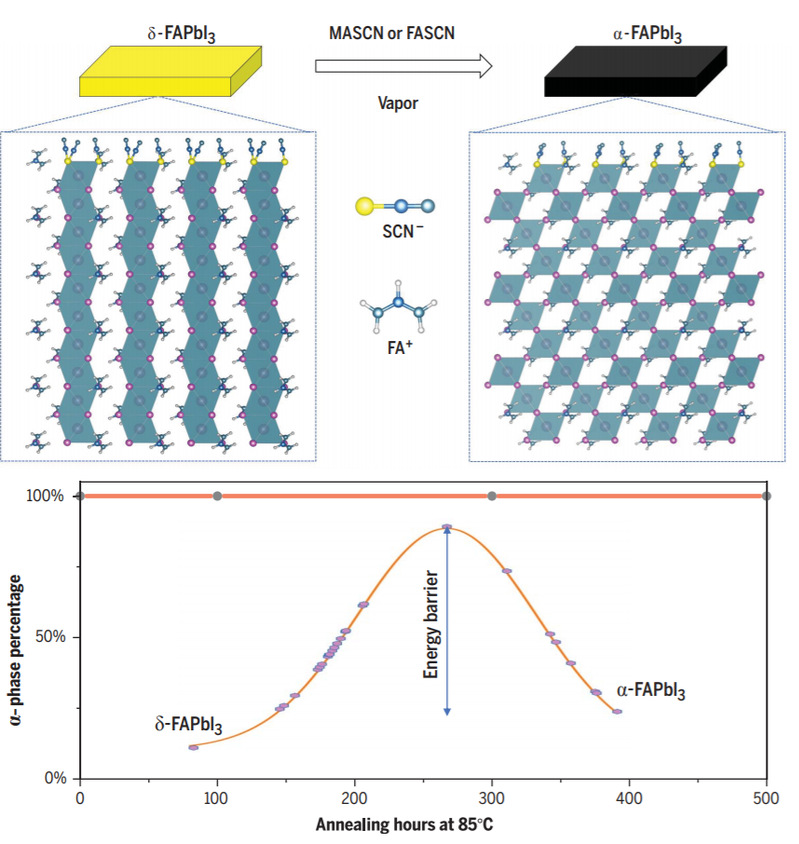Recently, Prof. Zhan Yiqiang and Prof. Zheng Lirong of the School of Information Science and Engineering, Fudan University , cooperating with EPFL group of Anders Hagfeldt and Micheal Graetzel, developed a vapor-assisted deposition method to convert β-FAPbI3 to the desired pure α-phase. The corresponding perovskite solar cells can reach a high PCE over 23%. The work has been published in Science, which titled "Vapor-assisted deposition of highly efficient, stable black-phase FAPbI3 perovskite solar cells".
Metal halide perovskite solar cells (PSCs) have reached a power-conversion efficiency (PCE) of 25.2%, thus exceeding other thin-film solar cells. FAPbI3 (where FA is formamidinium) has been shown to be an ideal candidate for efficient, stable PSCs. Obtaining highly crystalline, stable, and pure α-phase FAPbI3 films has been of vital importance. However, FAPbI3 undergoes a phase transition from the black α-phase to the photoinactive d-phase below 150°C. Previous approaches to overcoming this problem include mixing it with MA, Cs or Br ions. Here, we report a deposition method using methylammonium thiocyanate (MASCN) vapor treatment to convert β-FAPbI3 to the desired pure α-phase below the thermodynamic phase-transition temperature. Molecular dynamics (MD) simulations show that the SCN–anions promote the formation and stabilization of α-FAPbI3. These vapor-treated FAPbI3 PSCs exhibit outstanding photovoltaic and electroluminescent performance.

Stable and phase pure MASCN vapor-treated FAPbI3 films. Vapor-treated FAPbI3 films were annealed at 85°C for 500 hours in an N2 environment.
Although the phase transition from β- to α-phase FAPbI3 requires a high temperature, the treatment of d-phase FAPbI3 films with MASCN vapor allows the conversion to occur at temperatures below 150°C.MD simulations show that SCN– ions preferentially adsorb on the surface of β-FAPbI3 to replace iodide ions that are bound to Pb2+. This process disintegrates the top layer of face-sharing octahedra and induces the transition to the corner-sharing architecture of α-FAPbI3. Once the corner-sharing a-form is formed on the top surface, this layer templates the progression of the phase transition from β- to α-FAPbI3 toward the bulk. Once the pure α-FAPbI3 is formed, its back conversion to the β-phase is prevented by a high energy barrier.
We show a complete conversion from β- to α-FAPbI3 at 100°C using the MASCN vapor treatment method. This phase transition can also be achieved using FASCN vapor. The vaportreated FAPbI3 film remained in its pure black phase even after 500 hours of annealing at 85°C, whereas the reference FAPbI3 film formed mainly PbI2 during the heat exposure. X-ray diffraction data showed an improved crystallinity and preferred orientation of the FAPbI3 films after vapor treatment. One- and two-dimensional NMR experiments were used to probe changes in symmetry and quantify the incorporation of MA into the perovskite framework. Time-of-flight secondary ion mass spectrometrymeasurements confirmed that the MASCN content was mostly located near the surface region of the FAPbI3 films.We used theselow-defect-densitya-FAPbI3 films to make PSCs with >23% PCE, long-term operational stability, low (330 mV) open-circuit voltage (Voc) loss, and low (0.75 V) turn-on voltage of electroluminescence.
SCN– anions play a key role in promoting the formation and stabilization of α-FAPbI3. Vapor-treated FAPbI3 films showed long-term thermal stability. MD simulations showed that the pure α-FAPbI3 remained kinetically stable. These findings are important for developing stable and pure black-phase FAPbI3-based PSCs. Our vapor-treated FAPbI3 PSCs showed high efficiency and good longterm stability under maximum power point tracking conditions. Because of its high Voc and high external quantum efficiency electroluminescence yield, pure α-FAPbI3 will be useful for other applications such as light-emitting diodes and photodetectors.

